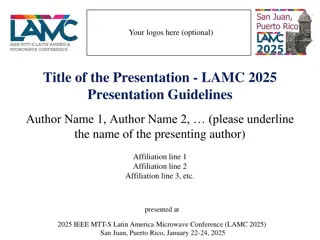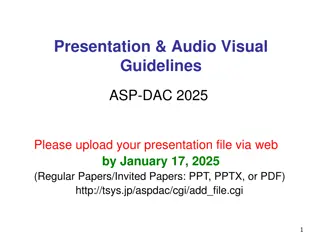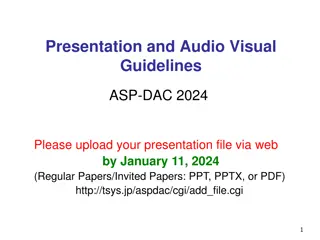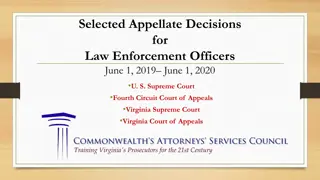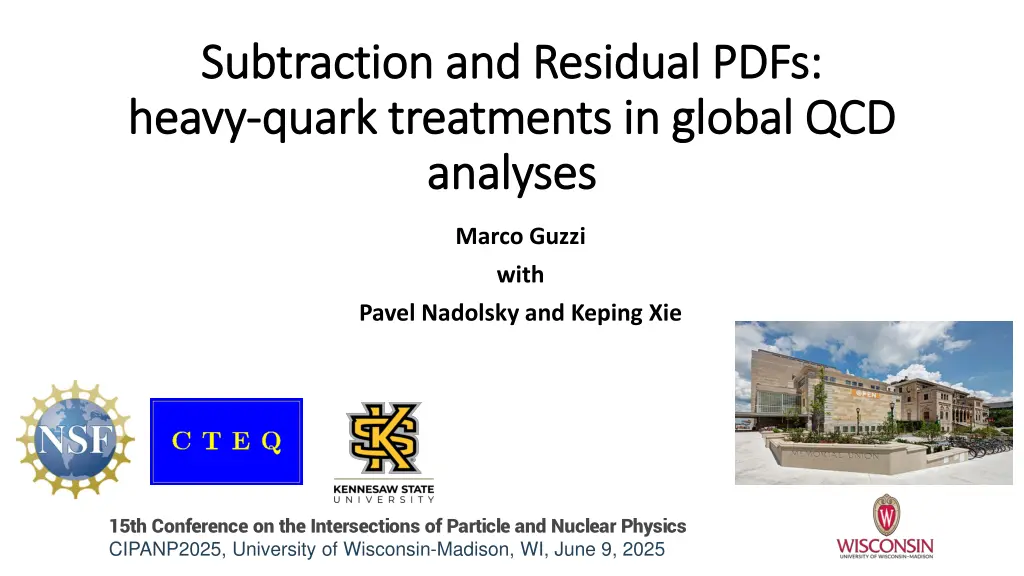
Global QCD Analyses of Proton PDFs and Heavy Quark Treatments
Explore the advancements in global QCD analyses of proton PDFs and heavy quark treatments presented at the 15th CIPANP2025 with a focus on subtraction and residual PDFs, motivations driving the research, and the implementation of ACOT-like GMVFN schemes. The discussions include the impact on observables, the need for consistent GMVFN schemes, and the evaluation of cross-sections in factorization schemes. Learn about the towards new CT25 PDFs and the goal to simplify GMVFN scheme implementations for improved extraction of PDFs and phenomenology.
Download Presentation

Please find below an Image/Link to download the presentation.
The content on the website is provided AS IS for your information and personal use only. It may not be sold, licensed, or shared on other websites without obtaining consent from the author. If you encounter any issues during the download, it is possible that the publisher has removed the file from their server.
You are allowed to download the files provided on this website for personal or commercial use, subject to the condition that they are used lawfully. All files are the property of their respective owners.
The content on the website is provided AS IS for your information and personal use only. It may not be sold, licensed, or shared on other websites without obtaining consent from the author.
E N D
Presentation Transcript
Subtraction and Residual PDFs: Subtraction and Residual PDFs: heavy heavy- -quark treatments in global QCD quark treatments in global QCD analyses analyses Marco Guzzi with Pavel Nadolsky and Keping Xie 15th Conference on the Intersections of Particle and Nuclear Physics CIPANP2025, University of Wisconsin-Madison, WI, June 9, 2025
Motivations Motivations Exp data at current and future colliders continue to extend on a wider range of collision energies and so do modern global analyses of proton PDFs 1/28
Towards new CTEQ (CT25) PDFs Towards new CTEQ (CT25) PDFs also dijet data, but don t (officially) know how to combine with inclusive jets 776 new data points from DY, ? ? and jets for CT25 2/28
Motivations Motivations Exp data at current and future colliders continue to extend on a wider range of collision energies and so do modern global analyses of proton PDFs. Increased sensitivity to mass effects, e.g., phase-space suppression, large radiative corrections to collinear ? ? production: magnitude comparable to ???? and ???? corrections. Need a consistent General Mass Variable Flavor Number (GMVFN) scheme 3/28
impact on many important observables DIS structure Functions Preliminary Figure by P. Nadolsky (2025) MG, Nadolsky, Lai, Yuan, PRD 2012 MG, Hobbs, Xie, Nadolsky, Yuan, PLB 2023 4/28
Motivations Motivations Exp data at current and future colliders continue to extend on a wider range of collision energies and so do modern global analyses of proton PDFs. Increased sensitivity to mass effects, e.g., phase-space suppression, large radiative corrections to collinear ? ? production: magnitude comparable to ???? and ???? corrections. Need a consistent General Mass Variable Flavor Number (GMVFN) scheme Natural to evaluate cross sections in a factorization (GMVFN) scheme, which assumes that the number of (nearly) massless quark flavors varies with energy, and at the same time includes dependence on heavy-quark masses in relevant kinematical regions. Particularly relevant for global PDF analyses 5/28
Outline/Goals Outline/Goals Simplify GMVFN scheme implementations to improve PDFs extractions and phenomenology ACOT-like GMVFN schemes: extended to pp collisions using the concept of subtraction and residual PDFs. Applied to various processes of interest: pp ? + ? + ? @NLO; MG, Nadolsky, Reina, Wackeroth, Xie, PRD 2024; pp ? + ? @NNLO; Biello, Gauld, MG, Nadolsky, Sankar, Wiesemann, Xie, Zanderighi (In prog.); DIS: Extension of ACOT-like schemes to aN^3LO; MG, Nadolsky, Xie, (In prog.) This effort is important to understand new high-precision data at colliders, and is connected to: Consistent treatment of HQ effects in PDFs (Intrinsic HQ, constrain HQ PDFs) DGLAP evolution @N^3LO NNLO N^3LO transition 6/28
Subtraction and Residual PDFs: Basic idea Subtraction and Residual PDFs: Basic idea Inclusive production of a HQ in pp collisions as an example The subtraction term avoids double counting and cancels enhanced collinear contributions from FC when ? 4?? 2 or ?? ?? Collinear splitting ?? ? ? LO FC LO FE Subtraction NLO FC S-ACOT-Massive-Phase-Space (S-ACOT-MPS) Mass fully retained in ??? Mass fully retained in ? and ??? allows us to get (FE-Subtraction) in one step Subtraction well defined also in the ?? 0 limit FE Subtraction facilitated by introducing Residual PDF: Other details in: K. Xie, Massive elementary particles in the standard model and its supersymmetric triplet Higgs extension. https://scholar.smu.edu/hum_sci_physics_etds/7, 2019. PhD Thesis Subtraction PDF 7/28
GMVFN Theory framework (pp collisions) GMVFN Theory framework (pp collisions) The differential cross section for ???? ? + ? where F contains at least one HQ, can be written After d /d? is UV renormalized, we identify its infrared-safe part d /d? by factoring out ``parton-level PDFs Convolution product with one variable Convolution product with two variables 8/28
GMVFN Theory framework (pp collisions) GMVFN Theory framework (pp collisions) The perturbative expansion of terms leads to operator-matrix elements (OMEs) * for ? ? ? Substituting these in the previous formula for ? and solving for ?(?) order by order in ?? one obtains Two forms for the OMEs *Our convention for the splitting functions . 9/28
Subtraction PDFs Subtraction PDFs (?) functions are determined, the hadronic cross section in pp collisions can be written as Once the ??? Then, the various subtraction ( sub ) terms can be collected as follows: In DIS, one proceeds in a similar fashion to reshuffle the various contributions in the Wilson coefficient functions. At this point we can define subtraction HQ PDFs 10/28
Residual PDFs Residual PDFs FE and SUB share the same matrix elements and can be combined in one piece in terms of residual PDFs! HQ, Subtraction and Residual PDFs near the b-quark threshold 11/28
Subtraction and Residual PDFs Subtraction and Residual PDFs Subtraction PDFs consist of convolutions between PDFs and universal operator matrix elements (OMEs). They are process independent. (3)) (J. Bl mlein is leading the effort in the calculation of the OMEs @N3LO. See Ablinger et al. PLB2024 and NPB2024 on ??? Subtraction and Residual PDFs are provided in the form of LHAPDF6 grids for phenomenology applications: https://sacotmps.hepforge.org/ https://sacotmps.hepforge.org/ The next generation of CTEQ global analyses will use a module to generate Subtraction and Residual CT-PDFs 12/28
This recipe has been applied to reactions of interest: 1.pp ? + ? + ?; (? = ?-quark) @NLO; M.G., Nadolsky, Reina, Wackeroth, Xie; PRD2024, 2410.03876 13/28
pp pp Z+Q+X @LO: cancellation pattern Z+Q+X @LO: cancellation pattern (for ?? ? + ? + ? this is ?(??2)) FE term Sub FC term Subtraction FE Sub FC 14/28
pp pp Z+Q+X @NLO: cancellation pattern Z+Q+X @NLO: cancellation pattern (for ?? ? + ? + ? this is ?(??3)) FE FC Sub FE FC Sub qg-channel gg-channel Virtual diagrams are not shown here, but are included in the calculation. 2410.03876 15/28
for ?? ? + ? + ? @NLO GMVFN scheme GMVFN scheme Xsec Xsec for @NLO Equivalently, with the d FE d sub reorganized in terms of HQ PDF residuals we obtain a very simple form 3 Lowest mandatory order (LMO) representation at NLO in that it retains only the unambiguous terms up to order ?? required by order-by-order factorization and scale invariance. Any ACOT-like scheme must contain such terms. 2410.03876, PRD 2024 16/28
This recipe has been applied to physical processes of interest: 1.pp ? + ? + ?; (? = ?-quark) @NLO; M.G., Nadolsky, Reina, Wackeroth, Xie; PRD2024, 2410.03876 2.pp ? + ?,@NNLO; Biello, Gauld, MG, Nadolsky, Sankar, Wiesemann, Xie, Zanderighi (In progress) 19/28
pp pp H+X @LO, NLO: cancellation patterns H+X @LO, NLO: cancellation patterns SB FE FC FE SB + 20/28
Flavor Flavor- -scheme matching in scheme matching in ??? The calculation of NNLO corrections in ?? ???, with parton shower matching in both massless (5FS) [2402.04025] and massive scheme (4FS) [2412.09510], opens new opportunities to study the flavour-scheme matchinginbbHusingsubtractedandresidualPDFs. State-of-the-art Only fully-inclusive matched results are known for ??? in different schemes: Santander matching [1112.3478] FONLL [1508.01529, 1607.00389]with current matching at N3LO5??+ NLO4?? [2004.04752] NLO + NNLLpart + yb yt matching [1508.03288, 1605.01733] Long-termgoal Matching of NNLO+PS 4FS and NNLO+PS 5FS using ACOT-like schemes with subtraction and residual PDFs at fully-differential level with parton-shower matching in the POWHEG fremework with the MiNNLOPS method. Biello, Gauld, MG, Nadolsky, Sankar, Wiesemann, Xie, Zanderighi[in progress] 21/28
???at the first order at the first order d /dpT,H [fb/GeV] 60 We first performed the S-ACOT matching at the first order by combining: bb H@LHC 13 TeV FlavorCreation(obtainedusingaLO??4FSgenerator) Flavor Excitation and corresponding subtraction (obtained by modifying an NLO??5FS generator with standard and subtractedPDFs) LO-FE LO-Matched-SACOT LO-FC 50 40 30 (before showering) 20 Preliminary 10 0 d /d LO-FE 1.4 1.2 1 0.8 0.6 0.4 0.2 0 10 20 30 40 50 pT,H 60 70 80 90 100 Figure by C. Biello and A. Sankar 22/28
???at the first order at the first order FullyexclusivematchedresultsinterfacedwithPYTHIA8fortheparton-showersimulation. d /dyH [fb] bb H@LHC 13 TeV d /dyH [fb] bb H@LHC 13 TeV 103 250 pT,j1>60GeV FE-(LO+PS) SACOT-Matched-(LO+PS) FC-(LO+PS) Setup: Preliminary 102 200 CT18NLO+CT18NLOsub ??= 4.75GeV ??= 125 GeV Preliminary 101 150 100 100 FE-(LO+PS) SACOT-Matched-(LO+PS) FC-(LO+PS) 10-1 50 MS bottom Yukawa with ???? = 4.18 GeV and three-loop running 10-2 0 d /d FE-(LO+PS) d /d FE-(LO+PS) 5 1.8 1.6 4 1.4 1.2 3 1 Standard scale variation via event reweighting in POWHEG. 0.8 2 0.6 0.4 1 0.2 0 0 -3 -2 -1 0 yH 1 2 3 -3 -2 -1 0 yH 1 2 3 Figure by C. Biello and A. Sankar 23/28
This recipe has been applied to physical processes of interest: 1.pp ? + ? + ?; (? = ?-quark) @NLO; M.G., Nadolsky, Reina, Wackeroth, Xie; PRD2024, 2410.03876 2.pp ? + ?,@NNLO; Biello, Gauld, MG, Nadolsky, Sankar, Wiesemann, Xie, Zanderighi (In progress) 3.DIS @N3LO in QCD MG, Nadolsky, Xie (In progress) 24/28
DIS @NNLO, @N^ DIS @NNLO, @N^3 3LO: cancellation patterns LO: cancellation patterns S-ACOT-? @NNLO NC DIS, MG, Nadolsky, Lai, Yuan, PRD 2012 Default GMVFN scheme for DIS in CTEQ PDF analyses At N^3LO we have (MG, Nadolsky, Xie, In prep.) S-ACOT-? @NNLO CC DIS Phys.Rev.D 105 (2022), 2107.00460; Gao et al. (3) ? ,? See also 2504.13317, by P. Risse et al. 25/28
Current bottlenecks for full implementation at Current bottlenecks for full implementation at NNLO and beyond in QCD NNLO and beyond in QCD 4-loop splitting functions (3)OMEs in the ? space. 3-loop ??? 26/28
Other results using ACOT-like schemes Charm hadroproduction and Z + c production at the LHC can constrain the IC contributions. LHCb Z+c data deserve attention as they can potentially discriminate gluon functional forms at ? 0.2 and improve gluon accuracy. FPF paper 2109.10905 For small ? below 10 4, higher-order QCD terms with ln(1/?) dependence grow quickly at factorization scales of order 1 GeV. FPF facilities like FASER will access novel kinematic regimes where both large-x and small-x QCD effects contribute to charm hadroproduction rate. [arXiv:2109.10905] Transverse momentum at central rapidity at LHCb 13TeV (LHCb data from JHEP 03 (2016) 159). Error bands are scale uncertainties. Rapidity distributions of prompt charm at the LHC 13 TeV in the very forward region (yc > 8). Error band represents the CT18NLO induced PDF uncertainty at 68% C.L. NLO theory predictions for the pT and y distributions obtained with CT18NLO and CT18XNLO PDFs compared to B production data from LHCb 13 TeV [arXiv:2203.06207] Theoretical uncertainties at NLO are large (O(50%)) and mainly ascribed to scale variation. This can be improved by including higher-order corrections which imply an extension of the S-ACOT-MPS scheme to NNLO 27/28
Concluding Remarks Concluding Remarks Developed theory framework to extend ACOT-like GMVFN schemes to pp collisions based on collinear fact., and Subtraction and Residual PDFs. ACOT-like schemes used to describe Z+b production differentially @NLO in QCD Work is in progress for Higgs production @NNLO, and DIS @aN^3LO Important for PDF analyses and to improve current understanding of exp data Subtraction PDFs provided in the form of LHAPDF grids to for phenomenology 28/28
BACK UP 29
Operator Matrix Elements From mass factorization on DIS structure functions (?) represent the renormalized operator-matrix elements (OME s) which are defined by The ??? where ?? are the renormalized operators which appear in the operator-product expansion of two electromagnetic currents near the light cone. 30
Further simplifications in ACOT-type schemes (???)? ??? 3 Lowest mandatory order (LMO) representation at NLO in that it retains only the unambiguous terms up to order ?? required by order-by-order factorization and scale invariance. Any ACOT-like scheme must contain such terms. 31
Further simplifications in ACOT-type schemes One generally can augment with extra radiative contributions from higher orders with the goal to improve consistency with the specific GMVFN scheme adopted in the fit of the used PDFs. The GMVFN scheme assumed for determination of CTEQ-TEA PDFs with up to 5 active flavors is closely matched with the following additional choices: 1. Evolve s( ) and PDFs fi( , ) with Nf = 5 at mb. The hard cross sections are also evaluated with Nf = 5 in virtual loops both for massive and massless channels. If the virtual contributions are obtained in the Nf = 4 scheme, they should be converted to the Nf = 5 scheme by adding known terms to the hard cross sections. 2. The sums over initial-state light quarks and antiquarks in are extended to also include the b-quark PDF via the introduction of the singlet PDF 3. replace in and in by f^(NLO) and f^(NLO), respectively. 4. The s and PDFs must be evolved at least at NLO, although evolution at NNLO is acceptable or even desirable in some contexts. 5. In the hard cross sections inside d FE d sub, dependence on the HQ mass can be eliminated altogether or simplified, producing a difference only in higher-order terms. 32
Further simplifications in ACOT-type schemes With the simplifications discussed above, we obtain 33













